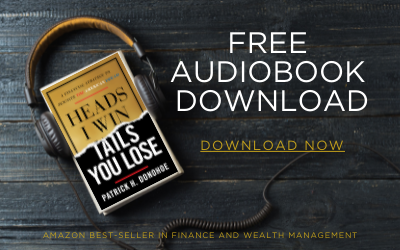When it comes to investing, logic isn’t always in the driver’s seat. Emotional investing—making decisions based on fear, anxiety, or short-term excitement—can quietly derail even the most carefully crafted financial plan. At Paradigm Life, we help clients shift from reaction to intention through the Perpetual Wealth Strategy™, a framework built to bring clarity, stability, and long-term control. By understanding how emotions influence financial decisions, you can build a strategy that not only protects your wealth but also aligns with your values.
The Elephant and the Rider: How Emotion Overrides Logic
In Switch, Dan and Chip Heath use the metaphor of the elephant and the rider to explain how our minds handle decision-making—especially under pressure. This concept offers valuable insight into the dynamics of emotional investing.
- The rider = logic and planning: The rider represents the rational mind—focused, thoughtful, and goal-oriented. It wants to follow a long-term plan and make smart financial decisions based on strategy. The rider looks ahead, analyzes risks, and sets clear financial targets. But it lacks the strength to control the elephant alone, especially in emotionally charged moments.
- The elephant = emotion and instinct: The elephant is powerful, emotional, and reactive. When calm, it cooperates with the rider. But when fear or uncertainty strikes, the elephant can take control—and steer everything off course. It prioritizes short-term relief over long-term goals, often acting impulsively. In financial contexts, this can lead to sudden decisions that derail years of progress.
- When emotion takes over: In moments of market volatility or financial stress, the emotional elephant often overrides the rational rider. This is when emotional investing occurs—buying high, selling low, or abandoning strategy entirely. These reactions are fueled by fear, not logic. Without a guiding framework, emotional responses can result in unnecessary losses or missed opportunities.
- Why it matters: Recognizing this inner conflict helps investors stay aware of how emotions can impact decisions. Awareness is the first step in avoiding emotional investing pitfalls and maintaining a clear, rational path forward. It empowers you to pause, reflect, and act based on strategy—not instinct.
How Emotional Investing Hurts Long-Term Wealth
Emotional investing can feel justified in the moment—but over time, it often leads to decisions that damage your financial future. Reacting to fear, greed, or uncertainty may seem like taking control, but it usually results in behavior that undermines long-term growth and stability.
Here’s how emotional investing affects wealth over time:
1. Panic-selling during market drops
- When markets dip, fear kicks in.
- Many investors sell off assets to avoid further loss—often locking in those losses permanently.
- These reactionary moves interrupt compounding and long-term growth.
- The market may recover, but your portfolio may not if you’ve exited too early.
2. Chasing high returns
- Seeing others profit from trendy investments can trigger FOMO (fear of missing out).
- This leads to buying high—often near the peak—without a clear strategy.
- Emotional investing driven by greed usually ignores fundamentals and increases risk.
- What looks like opportunity can become regret if timing is off.
3. Overreacting to volatility
- Market fluctuations are normal, but emotional responses exaggerate their impact.
- Constantly adjusting or abandoning your plan erodes consistency.
- Emotional investing turns temporary dips into long-term setbacks.
- Staying the course with a strategic foundation is what preserves real wealth
Balance Over Reaction: Creating Rational Space
Building a framework that supports both emotional awareness and rational action is essential to staying on course, especially when markets shift or pressure builds. This structure helps reduce the impact of emotional investing, giving you the clarity and confidence to make decisions that align with your long-term goals. Here’s how to create that balance:
Use Long-Term Strategies Like the Perpetual Wealth Strategy™
The Perpetual Wealth Strategy™ is designed to anchor your financial life with principles that don’t change—even when emotions run high. By focusing on cash flow, protection, and long-term wealth building, this strategy creates a solid foundation that guides decision-making. When you’re emotionally triggered, having a clear financial philosophy already in place makes it easier to respond with logic rather than impulse.
Organize Your Assets with the Hierarchy of Wealth™
The Hierarchy of Wealth™ helps you classify your assets based on safety, control, and liquidity. By placing your most stable and liquid assets—like whole life insurance—at the base of your financial structure, you reduce stress and pressure in uncertain times. When volatility hits, you can lean on Tier 1 assets rather than making high-risk moves.
Leverage Whole Life Insurance for Liquidity
Whole life insurance provides liquid cash value you can access through policy loans, without needing to sell off investments or trigger taxes. This means you can make smart decisions under pressure—whether it’s covering an emergency, funding an opportunity, or bridging a short-term financial gap. With this liquidity, you’re less likely to make fear-based choices like panic-selling. Instead, you have a reliable buffer that keeps you on track when emotions rise.
Work with a Wealth Strategist
Even the most well-structured strategy can be tested by stress or uncertainty. That’s why working with a Paradigm Life Wealth Strategist is so valuable. A strategist acts as a sounding board, helping you interpret what’s happening and respond with intention. They provide perspective, accountability, and reassurance—especially when emotional investing tendencies begin to surface.
The Role of Structure: Removing Emotion Through Strategy
When financial decisions are made without a plan, emotional investing often takes over. Fear, uncertainty, and market noise can quickly override logic, leading to reactive choices that harm long-term success. That’s why having a clear structure is essential—it brings order, clarity, and confidence to your financial life. With the right tools and strategies, you can reduce emotional interference and respond with intention.
Use the Hierarchy of Wealth™ to Prioritize with Purpose
The Hierarchy of Wealth™ is a foundational tool that organizes your assets based on risk, liquidity, and control. It helps you focus on stability and access first, so your financial base supports you during moments of stress.
- Tier 1 assets (e.g., whole life insurance cash value) provide safety, liquidity, and predictability.
- Tier 2 and tier 3 assets can be used for growth once your foundation is secure.
By following this structure, you reduce reliance on volatile assets during uncertain times, limiting emotional investing decisions.
Whole Life Insurance: Your Emotional Buffer
One of the most effective tools for reducing emotional stress in financial decisions is whole life insurance. Unlike market-based investments, it offers:
- Guaranteed cash value growth, immune to stock market swings.
- Liquidity through policy loans, so you don’t have to sell other assets in a panic.
- A long-term financial asset that supports both protection and legacy goals.
When emotions run high, having a liquid, stable asset allows you to pause, think, and act strategically instead of reactively.
Optimize Cash Flow to Reduce Financial Stress
Cash flow is the fuel of every sound financial strategy. When cash flow is unpredictable or restricted, fear sets in quickly. That’s when emotional investing spikes—people start making rash moves just to “fix” short-term problems.
Optimizing your cash flow through systems like the Perpetual Wealth Strategy™ provides:
- Consistency in income and expenses
- Flexibility to make decisions without panic
- Confidence to weather financial ups and downs
With steady cash flow and liquidity, you’re far less likely to act out of fear or urgency.
The Perpetual Wealth Strategy™: Confidence by Design
When uncertainty strikes, confidence comes from having a system that’s built to respond—not react. That’s the power of the Perpetual Wealth Strategy™, a proven approach that helps eliminate emotional investing by anchoring your financial life in structure, clarity, and control. Instead of chasing returns or reacting to market noise, you operate from a foundation built on principles that don’t change—no matter what the economy does.
Built on Three Pillars: Cash Flow, Protection, and Wealth
The Perpetual Wealth Strategy™ is centered around three core pillars that work together to keep your decisions intentional and focused:
Cash Flow: Your Financial Lifeline
- Cash flow is the foundation of your financial health—it fuels your lifestyle and future decisions.
- Optimizing your cash flow means you’re not forced to sell investments under pressure.
- When income is steady and accessible, you’re less likely to fall into emotional investing traps driven by panic or scarcity.
- This pillar gives you freedom to act calmly, not react impulsively.
Protection: Safeguarding What Matters
- Protection isn’t just about insurance—it’s about shielding your wealth, your mindset, and your financial future.
- Tools like whole life insurance create a stable financial base, with guaranteed growth and access to liquidity.
- With the right protection in place, you avoid emotionally driven decisions during volatile times.
- It allows you to operate from a place of security instead of fear.
Wealth: Growth with Purpose
- Building wealth is about more than returns—it’s about doing it in a way that’s sustainable and aligned with your goals.
- The Perpetual Wealth Strategy™ encourages strategic allocation through the Hierarchy of Wealth™, prioritizing assets that offer control and stability first.
- This structure helps reduce risk exposure and prevent the reactive behaviors that often derail long-term growth.
- With a clear path to build and preserve wealth, emotional investing becomes less tempting—and less necessary.
FAQs
What are emotional investing pitfalls?
Emotional investing pitfalls include panic-selling during downturns, chasing high returns out of fear of missing out (FOMO), and abandoning long-term strategies due to short-term fear or excitement. These reactive decisions often lead to losses, missed opportunities, and long-term financial instability.
How can I avoid emotional investing?
Avoiding emotional investing starts with having a clear financial framework. Implement strategies like the Perpetual Wealth Strategy™, use tools such as whole life insurance for liquidity, and follow the Hierarchy of Wealth™ to prioritize stability. Most importantly, work with a Wealth Strategist to keep your decisions aligned with your long-term goals—especially during stressful times.
Why is strategy more effective than emotion?
Strategy provides structure, clarity, and consistency. Emotion is unpredictable and often rooted in fear or urgency. By following a strategy, you reduce the risk of emotional investing and gain confidence in your decisions. A long-term plan helps you stay calm, focused, and financially stable—regardless of market fluctuations.
How does whole life insurance help reduce emotional investing?
Whole life insurance offers guaranteed growth, liquidity through policy loans, and stability that isn’t tied to market performance. When markets are volatile, having access to non-correlated assets gives you the flexibility to make calm, confident decisions—without resorting to emotional investing behaviors like panic-selling or rash withdrawals.
Can emotional investing impact my retirement strategy?
Absolutely. Emotional investing can cause premature withdrawals, misallocated assets, and inconsistent income—especially harmful during retirement years. Without a structured approach, such decisions can reduce your ability to sustain your lifestyle and pass on wealth. A clear, principle-based strategy helps protect your retirement from emotionally driven errors.
What role does the Hierarchy of Wealth™ play in reducing emotion?
The Hierarchy of Wealth™ helps you organize assets from most secure to most volatile. By focusing on Tier 1 assets—such as cash value in whole life insurance—you create a solid base of stability and access. This reduces financial pressure and emotional reactivity when external markets fluctuate, keeping you grounded and strategic.
When is the best time to put a strategy in place?
The best time is before emotions are triggered by a financial event. Building your strategy early allows you to respond—not react—when markets change or life gets unpredictable. Whether you’re just starting or already building wealth, now is the ideal time to put a system in place that supports rational, confident decisions.
Choose Strategy Over Emotion
Emotional investing can easily disrupt even the best intentions—but it doesn’t have to define your financial journey. With whole life insurance and the Perpetual Wealth Strategy™, you gain the structure, liquidity, and long-term vision needed to make calm, confident decisions—regardless of what the market does.
Speak with a Paradigm Life Wealth Strategist today to build your personal, emotion-proof strategy and take control of your financial future with clarity and confidence.







